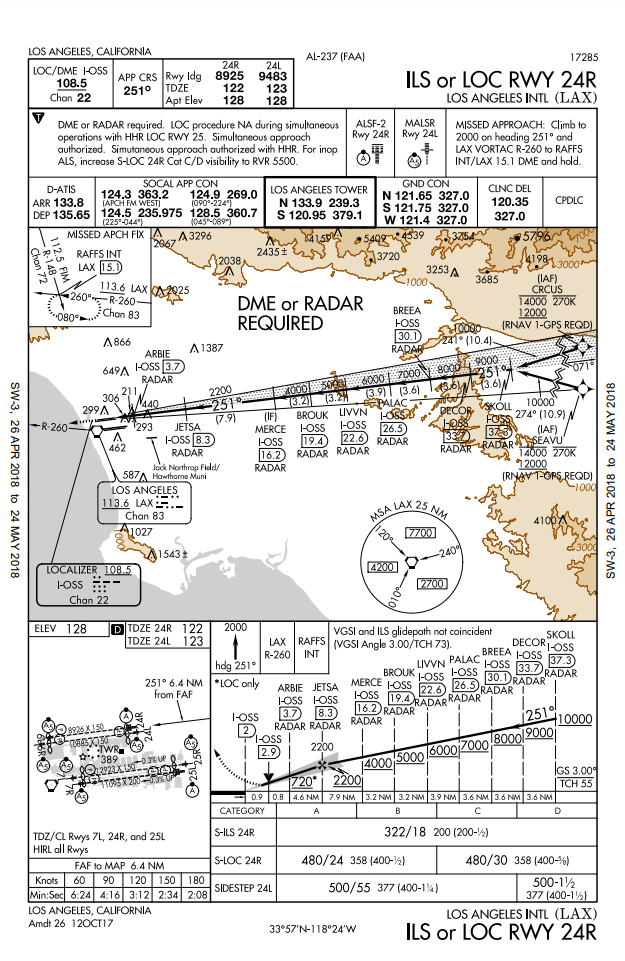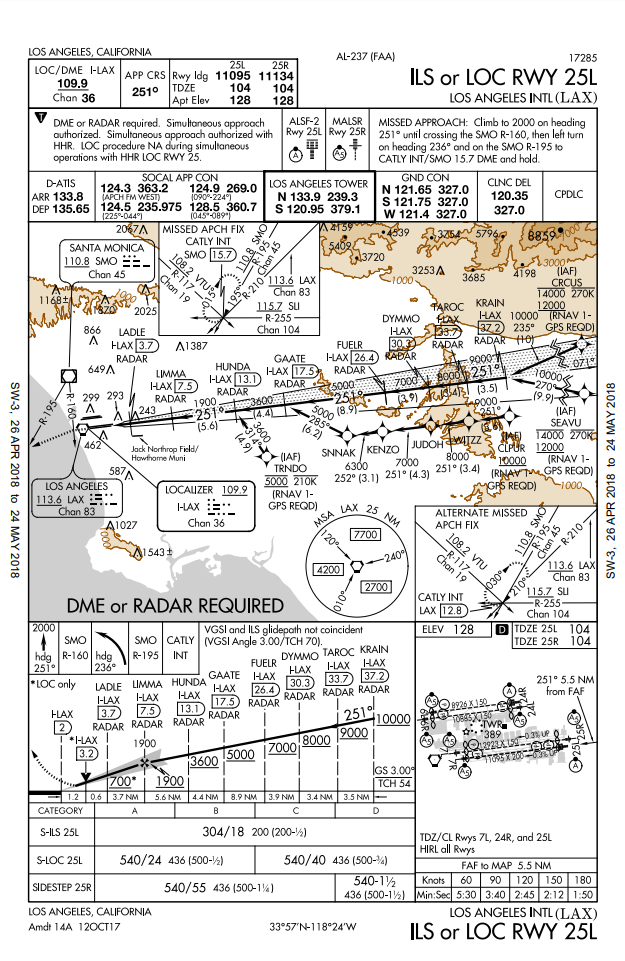

Controller Schedule
January 10th, 2026
Session with RR
1430 - 1600 PST / 2230 - 0000 Zulu
OTS with BY
1730 - 1900 PST / 0130 - 0300 Zulu
The ATIS and Arrival Briefing
First things first: Check the ATIS! LAX ATIS is on 133.8.
You should check the ATIS soon after you start your initial descent and before reaching FL180 (so you will know the altimeter setting). The ATIS has everything you need to know about the weather, arrival runways, NOTAMS and anything else pertinent to ensuring everyone is all smiles when they leave your plane (although we do judge your landings, we can’t make them for you). You should be able to tune to the ATIS at least 40 miles away from LAX.
Though we're happy to answer questions on the frequency, the frequency can be VERY busy during events. So, asking your busy controller which runways are in use or the altimeter setting is not a good use of valuable frequency time.
So, get your ATIS and brief yourself on the arrival and potential approaches. If it's not included in the ATIS, and you need to know, then ask your controller.
When you switch from Center to Approach, call up Approach with the following information:
Example: "SoCal Approach, AAL123, flight level 200 descending with information foxtrot." Boom! Done. You’ve just earned a special star you can put on your pilot certificate. (Call the FAA to order. Expect delivery in 12-87 weeks.)
Don’t I have to tell him what arrival I’m on? Nope! That’s in your flightplan, and your controller is required to pass a basic reading test before he starts his shift.
What if I am told to descend except maintain xxx altitude? Then add the altitude restriction you were given!
Example: “SoCal Approach, AAL123, flight level 200 descending 17,000 with information foxtrot.”
When you do this, it saves time because your controller has now immediately validated your altitude and knows that you have the current weather information. That means he doesn't have to quiz you about everything. I mean, what are you trying to hide?
You also don't need to report where you are. When you're within radar coverage and handed from one controller to the next, we already know where you are. Yes, we ARE watching you...
Easy peasy!
Common Mistakes:
Arrival Procedures
Typical arrivals into LAX include the IRNMN from the northwest, the ANJLL from the northeast and the HLYWD from the east.
These replace the SADDE, RIIVR and SEAVU arrivals and are optimized profile descent (OPD) arrivals. OPDs are designed to allow aircraft to descend continuously rather than descending and leveling multiple times.
You'll get your initial descent from Los Angeles Center. You'll likely hear something like: "AAL123, descend via the IRNMN1 arrival" or "AAL123, descend via the IRNMN1 arrival except maintain 12,000."
In the first case, you should follow the published crossing restrictions and speeds all the way to the lowest altitude on the appropriate arrival until you receive further ATC instruction.
In the second case, you should do the same except stop at the altitude instructed. Usually, you'll be given further descent by approach prior to reaching that altitude.
All you have to do is make sure LNAV and VNAV are doing what they’re supposed to and the plane is crossing within the altitude and speed restrictions shown on the STAR. If you have a problem, just let us know! We’d rather get you setup with alternatives (vectors, different arrival) sooner than later. Letting us know early also gives us more time to coordinate with other controllers.
Common Arrival Mistakes:
Approach Procedures
Approaches into LAX is where it gets tricky. LAX is surrounded by several airports and thus has very tight airspace boundaries. Most of the time, LAX runs in west operations. This means arrivals land on the outboard runways (24R and 25L).
If LAX is IMC, you should expect the ILS runway 24R or 25L approach.
If LAX is VMC, you should expect a visual approach to runway 24R or 25L and you should expect to intercept the localizer. Why? Visual approaches allow controllers to handle more traffic because we can use pilot-applied visual separation between aircraft.
If you're starting your approach at an IAF that feeds from a STAR, we will clear you for the instrument approach initially. We will then ask you to report traffic in front of you in sight. Once you do, we'll clear you for the visual approach and then you will use visual separation to safely follow the preceding aircraft.
If you are being vectored for the visual approach, you'll also be given a heading to fly to intercept the localizer either with or just prior to your visual approach clearance.
Example:
ATC: "AAL123, traffic 10 o'clock, 5 miles, westbound, a Boeing 737 at 3,200 descending for runway 25L. Report traffic in sight."
You: "Traffic in sight, AAL123."
ATC: "AAL123, turn left heading 280, intercept final approach course, number 2, cleared visual approach runway 25L."
You can and should continue to follow the instrument approach as you would normally. The main difference is that you are maintaining visual separation. (The other difference is a visual approach clearance does not authorize you to fly any missed approach procedure automatically. You will receive vectors if you go missed.)
Arriving from the East and Northeast
If you're coming down the ANJLL or HLYWD arrivals, you will start the approach from either CRCUS (from the ANJLL STAR) or SEAVU (from the HLYWD STAR).
You'll hear something like: "AAL123, at [CRCUS or SEAVU] cleared ILS runway [24R or 25L] approach."
This means you will continue on the ANJLL or HLYWD arrival and then start the ILS approach using CRCUS/SEAVU as your initial approach fix (IAF).
NOTE: The ANJLL and HLYWD arrivals terminate at CRCUS and SEAVU respectively. And, CRCUS and SEAVU are IAFs for both ILS RWY 24R and 25L approaches. The arrivals feed directly into these approaches to make everything seamless.
You won't actually capture the localizer that far out, so you need to be RNAV 1 or GPS capable to start the approach. If you are not, be sure to remind your controller.
ILS RWY 24R: After you cross CRCUS or SEAVU, your next fixes will be SKOLL, then DECOR, and so on until you intercept the localizer and glideslope.

ILS RWY 25L: After you cross CRCUS or SEAVU, your next fixes will be KRAIN, then TAROC, and so on until you capture the localizer and glideslope.

Common Approach Mistakes:
Arriving from the Northwest and West
If you're arriving via the IRNMN or RYDRR arrivals, you will likely be given vectors to an approach. Listen carefully for instructions from your ATC controllers.
Common Mistakes:
SPECIAL: ILS RWY 25L Approach at CLPUR
This is VERY LIKELY to be used during heavy arrival pushes!
In order to handle more traffic on simultaneous parallel approaches, the ILS RWY 25L approach has a new initial approach fix (IAF) named CLPUR. The path starting at CLPUR keeps 25L arrivals more separated from those on 24R.
While desceding via the ANJLL or HLYWD arrivals, your controller may instruct you to start your approach at CLPUR rather than CRCUS or SEAVU.
You may be told in advance to expect direct CLPUR for ILS runway 25L approach.
Then, you will hear something like: "AAL123, after crossing [CRCUS or SEAVU] cleared direct CLPUR, cleared ILS runway 25L approach."
Check, double check and triple check your FMC to be sure you proceed to CLPUR when instructed and then WITZZ, JUDOH and so on until you intercept the localizer at GAATE.
Also double check that you follow the published altitude restrictions.
As noted earlier, do NOT proceed direct HUNDA after SEAVU or CLPUR.
Landing at LAX
Just a few notes here:
Wrapping it All Up
Flying into LAX is great fun! But, with tight airspace and strict requirements, a little planning and practice goes a long way. Remember, we really want everyone to have a fun time with minimal delays. We enjoy controlling, and we enjoy having you as pilots.
As always, it's better to prepare and ask your controller a question rather than to assume and cause delays for yourself. If you can't fly a particular procedure or have a problem, let us know immediately so we can make arrangements for you!
If you have any questions about the event, feel free to contact me at [email protected].
Nick Christopher
ZLA Event Coordinator